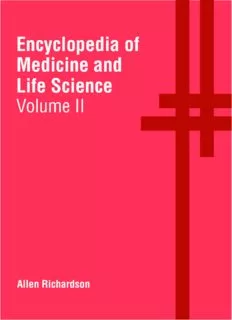
Encyclopedia of Medicine and Life Science PDF
Preview Encyclopedia of Medicine and Life Science
Encyclopedia of Medicine and Life Science Volume II Allen Richardson Encyclopedia of Medicine and Life Science Volume II "This page is Intentionally Left Blank" Encyclopedia of Medicine and Life Science Volume II Edited by Allen Richardson Published by Learning Press, 5 Penn Plaza, 19th Floor, New York, NY 10001, USA Encyclopedia of Medicine and Life Science: Volume II Edited by Allen Richardson © 2018 Learning Press International Standard Book Number: 978-1-9789-0798-0 This book contains information obtained from authentic and highly regarded sources. Copyright for all individual chapters remain with the respective authors as indicated. A wide variety of references are listed. Permission and sources are indicat- ed; for detailed attributions, please refer to the permissions page. Reasonable efforts have been made to publish reliable data and information, but the authors, editors and publisher cannot assume any responsibility for the validity of all materials or the consequences of their use. Copyright of this ebook is with Learning Press, rights acquired from the original print publisher, Foster Academics. The publisher’s policy is to use permanent paper from mills that operate a sustainable forestry policy. Furthermore, the publisher ensures that the text paper and cover boards used have met acceptable environmental accreditation standards. Trademark Notice: Registered trademark of products or corporate names are used only for explanation and identification without intent to infringe. Contents Preface VII Chapter 1 HIV-1 Trans Infection of CD4+ T Cells by Professional Antigen Presenting Cells 1 Charles R. Rinaldo Chapter 2 Pathology-Dependent Effects Linked to Small Heat Shock Proteins Expression: An Update 31 A.-P. Arrigo Chapter 3 Stress in Obesity and Associated Metabolic and Cardiovascular Disorders 50 Paul Holvoet Chapter 4 B Cells in Autoimmune Diseases 69 Christiane S. Hampe Chapter 5 Molecular Cochaperones: Tumor Growth and Cancer Treatment 87 Stuart K. Calderwood Chapter 6 The Need for Development of New HIV-1 Reverse Transcriptase and Integrase Inhibitors in the Aftermath of Antiviral Drug Resistance 100 Mark A. Wainberg Chapter 7 The Genetics of Alzheimer’s Disease 128 Robert C. Barber Chapter 8 Current and Future Therapies for Multiple Sclerosis 142 Alireza Minagar Chapter 9 Chronic Heart Failure: We Are Fighting the Battle, but Are We Winning the War? 153 John J. Atherton Chapter 10 Diabetes Technology: Markers, Monitoring, Assessment, and Control of Blood Glucose Fluctuations in Diabetes 169 Boris P. Kovatchev Chapter 11 Brown Adipose Tissue Growth and Development 183 Michael E. Symonds __________________________ WORLD TECHNOLOGIES __________________________ VI Contents Chapter 12 Kinome Profiling 197 Maikel P. Peppelenbosch Permissions List of Contributors __________________________ WORLD TECHNOLOGIES __________________________ Preface The vast field of life sciences comprises of the fields of science that consist of the scientific study of living organisms like microorganisms, animals, plants and human beings. It also includes related matters like bioethics. While biology remains the central focus of the life sciences, technological developments in biotechnology and molecular biology have led to a mushrooming of specializations and interdisciplinary subjects. Life science is a field that is helpful in improving the standard and quality of life. There are applications for life sciences in medicine, health, agriculture as well as in pharmaceutical and food science industries. There is considerable overlap between many of the topics of study in the life sciences. Life sciences also encompass the fields of life systems technologies, food processing, biotechnology, biomedical technologies, environmental science and bio-medical devices. Organizations and institutions also devote the bulk of their efforts in the various stages of research, development, technology transfer and commercialization. Most life scientists are largely involved in research and development and work in the laboratory or field. There are many opportunities available even in distantly related areas such as administration, management, illustrating, service work, teaching, financial support, legal support, writing, sales and even photography. This book is an attempt to compile and collate all available research on new ideas in life sciences under one umbrella. I am grateful to those who put their hard work, effort and expertise into these research projects as well as those who were supportive in this endeavour. Editor __________________________ WORLD TECHNOLOGIES __________________________ "This page is Intentionally Left Blank" __________________________ WORLD TECHNOLOGIES __________________________ 1 Trans + HIV-1 Infection of CD4 T Cells by Professional Antigen Presenting Cells CharlesR.Rinaldo DepartmentofInfectiousDiseasesandMicrobiology,UniversityofPittsburghGraduateSchoolofPublicHealth, Pittsburgh,PA15261,USA CorrespondenceshouldbeaddressedtoCharlesR.Rinaldo;[email protected] AcademicEditors:M.ClementiandZ.Stamataki Sincethe1990swehaveknownofthefascinatingabilityofacomplexsetofprofessionalantigenpresentingcells(APCs;dendritic + cells,monocytes/macrophages,andBlymphocytes)tomediateHIV-1transinfectionofCD4 Tcells.Thisresultsinaburstof virusreplicationintheTcellsthatismuchgreaterthanthatresultingfromdirect,cisinfectionofeitherAPCorTcells,ortrans infectionbetweenTcells.SuchAPC-to-Tcelltransinfectionfirstinvolvesacomplexsetofvirussubtype,attachment,entry,and replicationpatternsthathavemanysimilaritiesamongAPC,aswellasdistinctdifferencesrelatedtovirusreceptors,intracellular trafficking,andproductiveandnonproductivereplicationpathways.TheendresultisthatHIV-1cansequesterwithintheAPCfor severaldaysandbetransmittedviamembraneextensionsintracellularlyandextracellularlytoTcellsacrossthevirologicsynapse. VirusreplicationrequiresactivatedTcellsthatcandevelopconcurrentlywiththeeventsofvirustransmission.Furtherresearchis essentialtofillthemanygapsinourunderstandingofthesetransinfectionprocessesandtheirroleinnaturalHIV-1infection. 1.Introduction replication of virus in T cells, that is, orders of magnitude morethancisinfectionofeitherAPCorTcells,andTcell- Theuptakeofhumanimmunodeficiencyvirus1(HIV-1)by to-TcellorAPC-to-APCtransinfections. professionalantigenpresentingcells(APCs)andsubsequent + TheoutcomeoftheAPC-to-Tcelltransinfectionprocess transferofvirustoCD4 Tcellscanresultinexplosivelevels has been considered to be central to sexual transmission of of virus replication in the T cells. This could be a major HIV-1atmucosal(analandvaginal)andepidermal(foreskin) pathogenic process in HIV-1 infection and development of sites [9–11]. A further, potentially critical feature is its role acquiredimmunodeficiencysyndrome(AIDS).Thisprocess in progression of HIV-1 infection. In either case, the initial of trans (Latin; to the other side) infection of virus going phaseoftheHIV-1transinfectionprocessinvolvesunique,cis across from the APC to the T cell is in contrast to direct, interactionsandreplicationcyclesofvirusinthemajortypes cis (Latin; on this side) infection of T cells by HIV-1. Note that this is a narrow definition of trans infection, as direct, ofprofessionalAPC,thatis,subsetsofdendriticcells(DC), cell-to-cell spread of virus is a classic phenomenon in viral monocytes/macrophages,andBlymphocytes.Recentreviews infections [1], including HIV-1 [2, 3]. In fact, T cell-to-T have focused on DC-T cell [12] and macrophage-T cell [13] cell infection involves many factors that are part of APC- trans infections. This review will focus on the role of each to-T cell trans infection, including expression of CD4 on T typeofAPCinHIV-1transinfection,howtheseinfectedcells + cellsandformationofavirologicsynapse[4,5]andevasion transfervirustotheCD4 Tcell,andtheoutcomeofthis“kiss of neutralizing antibody [6] and the viral inhibitory effects of death.” Note that this review does not cover information of antiretroviral treatment (ART) [7, 8]. The use of trans ontransinfectionofsimianimmunodeficiencyvirus(SIV)in infectioninthisreview,however,referstotheinvitromodel nonhumanprimates.Thereaderisreferredtorecentreviews where infection of APC with low levels of HIV-1 leads to onSIVinfectionforthisinformation[14,15]. __________________________ WORLD TECHNOLOGIES __________________________
Description: